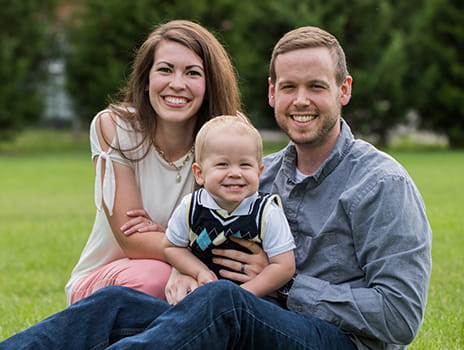Expert Treatment Helps Couple Become a Family


For Andrew and Brieanna Claassen, sharing life's twists and turns just comes naturally. From their early moments as childhood friends, to their days as high school sweethearts in McPherson, Kansas, to their young married life, they have navigated most of the big moments together.
This strong foundation helped them through Andrew's leukemia diagnosis and lifesaving care in 2015. And when cancer treatment impacted their fertility, they drew on this strength to find answers.

Some cancer treatments can cause infertility. That's why we offer fertility preservation services to patients who want to be able to conceive after they complete their cancer treatment. Services include:
To the Claassens, fall 2015 sounded like an ideal time to have a baby. Both in their mid-20s, they were ready to grow their little family. Life had a host of other plans that year, however.
In April 2015, Andrew underwent knee surgery. On May 2, Brieanna graduated with her master's degree in counseling. They made an offer on their first home. And after weeks of pain and other symptoms, Andrew was diagnosed with acute myeloid leukemia (AML), a fast-growing cancer of the bone marrow.
Treatment began immediately to give Andrew a fighting chance. He received intense chemotherapy, a blood stem cell transplant and total body irradiation, which causes infertility.
Before treatment, his experienced care team at The University of Kansas Cancer Center worked with the couple to complete sperm cryopreservation.
It really showed how much she cared about us as people and how she went above and beyond to show us that care. She was really fantastic. – Brieanna Claassen
The blood stem cell transplant was a success. With Andrew in complete remission, the Claassens set their hearts on their dream for a baby. They were prepared for a challenge, however, because Andrew's cancer treatment left them with only one viable sperm sample.
"In the back of our minds, we were hopeful but very guarded," Brieanna says.
They visited reproductive endocrinologist Kristin Holoch, MD, one of the expert physicians with The University of Kansas Health System's advanced reproductive medicine team. She and other nationally recognized physicians offer the Kansas City region's most comprehensive infertility services.
Dr. Holoch recalls their cautiously optimistic first visit.
We offer a variety of appointment types. Learn more or call 913-588-1227 to schedule now.
"Here was this couple who were so very sweet and excited to have a baby," she says. "They had just come through this enormously stressful cancer treatment, and it was not very far behind them. He was still wearing a mask during our first visits. We all wanted this to work out for them."
Dr. Holoch encouraged them to first try intrauterine insemination (IUI). During an IUI procedure, sperm cells are placed directly into a woman's cervix or uterus. For couples with unexplained infertility or male fertility issues, it can often be the answer.
"This is usually the course we suggest first in cases such as this, where there are no known female fertility problems," Dr. Holoch says.
But the first try was not successful, and Brieanna did not respond well to medication to prepare for a second round. Wary of using too much of their banked sperm, which was limited, the couple met with a nurse coordinator to talk about trying in vitro fertilization (IVF). In the IVF process, eggs and sperm are retrieved, and fertilization is induced in a laboratory environment by an embryologist.
The tide began to turn in their favor. Through a financial counselor with the reproductive team, Brieanna learned of a grant from the Livestrong Foundation that could help fund IVF expenses. She applied for and received the grant, which helped pay for portions of her IVF medication.
They were ready for the next step. Their embryologist worked with Dr. Holoch to ensure the Claassens had the best chance possible for success.
Their embryologist recommended intracytoplasmic sperm injection (ICSI) – a process in which sperm is directly injected into each egg versus co-incubating eggs and sperm together.
In April 2016, Brieanna underwent an egg retrieval procedure. A total of 12 eggs were fertilized using ICSI to increase the likelihood of success. Of these, 3 eggs started growing. Brieanna was disappointed to see their hopes "shrinking," but Dr. Holoch assured her the quality of the embryos was good.
On May 4, 2016, Brieanna underwent frozen embryo transfer. The day following Mother's Day, she had a positive home pregnancy test.
They were excited but cautious. "At this point, we were used to getting bad health news, and we were kind of prepared for disappointment but hoping for the best," Brieanna says.
The compassion of their care team helped them push through their trepidation.
Early on, Brieanna experienced heavy spotting, and the couple feared they were having a miscarriage. She called the fertility team, and care providers set up an emergency ultrasound first thing the next morning. Brieanna and Andrew heard a reassuring heartbeat, and afterward Dr. Holoch met with them to ensure they were doing okay.
"It really showed how much she cared about us as people and how she went above and beyond to show us that care. She was really fantastic," says Brieanna. On January 24, 2017, Andrew and Brieanna welcomed their son, Milo – a healthy, 8-pound, 14-ounce addition to their little family.
Since the Claassens used IVF to conceive, they have 2 frozen embryos remaining to use when they are ready for another baby.
"The goal of an IVF cycle is to create enough embryos so a couple has the potential to complete their family with just that one cycle," says Dr. Holoch.
At that time, Brieanna will receive estrogen to build the lining of her uterus, followed by progesterone. She will then undergo an ultrasound-guided frozen embryo transfer procedure. If for some reason this does not result in a pregnancy in 2 tries, they will need to begin a new IVF cycle. The frozen embryos are a promising start, however.
Since the couple’s procedure generated multiple embryos from one retrieval, their family now has the potential for brothers and sisters to be conceived at the same time but born at different times.
Patient testimonial: As with all treatments, individual patient results vary. It is important to discuss your treatment options with your healthcare provider.